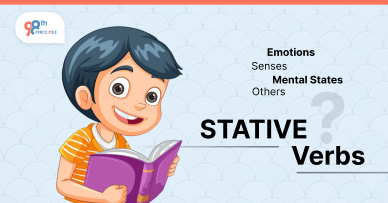Stative verbs are an interesting aspect of English grammar that describes states or conditions rather than actions. Although they are verbs, they function differently from action verbs. Let’s explore what stative verbs are, their definition, and some examples to understand them better.
Download FREE English Worksheets!
What is a Stative Verb?
A stative verb describes a state of being, condition, or situation that is stable or unlikely to change. These verbs often refer to thoughts, emotions, senses, relationships, or possessions. Unlike action verbs, which show what the subject is doing, stative verbs describe what the subject is.
A stative verb is a type of verb that expresses a state rather than an action. Stative verbs can describe mental states (e.g., “believe”), emotional states (e.g., “love”), physical states (e.g., “contain”), or qualities (e.g., “seem”).
Examples and Explanation
-
Example: She knows the answer.
-
Breakdown:
-
She (subject)
-
knows (stative verb)
-
the answer (object)
-
-
Explanation: The verb “knows” describes a mental state of understanding or awareness, rather than an action.
-
-
Example: They love
-
Breakdown:
-
They (subject)
-
love (stative verb)
-
chocolate (object)
-
-
Explanation: The verb “love” describes an emotional state of affection or preference, not an action.
-
-
Example: This book belongs to me.
-
Breakdown:
-
This book (subject)
-
belongs (stative verb)
-
to me (prepositional phrase)
-
-
Explanation: The verb “belongs” describes a state of possession or ownership, rather than an action.
-
Why Stative Verbs are Important?
Stative verbs are crucial because they help us describe conditions, states, and relationships that are not actions. They provide a way to express thoughts, feelings, and qualities, making our language richer and more descriptive.
More Examples
-
Example: I believe in you.
-
Breakdown:
-
I (subject)
-
believe (stative verb)
-
in you (prepositional phrase)
-
-
Explanation: The verb “believe” describes a mental state of trust or confidence.
-
-
Example: The cake tastes delicious.
-
Breakdown:
-
The cake (subject)
-
tastes (stative verb)
-
delicious (subject complement)
-
-
Explanation: The verb “tastes” describes a sensory state, indicating how the cake is perceived by the senses.
-
Types of Stative Verbs with Examples and Explanations
Stative verbs describe states or conditions rather than actions. They can be categorized into several types based on the kind of state they express. Let’s explore these types with examples and explanations.
1. Emotion Stative Verbs
These verbs describe emotional states or feelings.
Examples:
- Love: I love my family.
- Explanation: “Love” describes an emotional state of affection.
- Hate: She hates waking up early.
- Explanation: “Hate” describes an emotional state of strong dislike.
2. Mental or Cognitive Stative Verbs
These verbs describe mental states or cognitive processes.
Examples:
- Know: He knows the answer.
- Explanation: “Knows” describes a mental state of awareness or understanding.
- Believe: They believe in hard work.
- Explanation: “Believe” describes a mental state of conviction or trust.
3. Possession Stative Verbs
These verbs describe states of ownership or possession.
Examples:
- Have: She has a new car.
- Explanation: “Has” describes a state of possession.
- Own: They own several properties.
- Explanation: “Own” describes a state of ownership.
4. Senses (Perception) Stative Verbs
These verbs describe sensory perceptions.
Examples:
- See: I see a bird in the tree.
- Explanation: “See” describes a sensory perception of sight.
- Hear: He hears music from the next room.
- Explanation: “Hear” describes a sensory perception of sound.
5. Other Conditions and States
These verbs describe various other states or conditions.
Examples:
- Seem: She seems happy.
- Explanation: “Seems” describes a state of appearance or impression.
- Contain: This box contains old photos.
- Explanation: “Contains” describes a state of holding or including something.
Stative verbs are versatile and can describe a wide range of states and conditions, including emotions, mental states, possession, sensory perceptions, and other conditions. Understanding these types helps in using stative verbs correctly to make your language more descriptive and expressive.
Stative verbs are key to describing states and conditions, enriching our language by expressing emotions, mental states, possession, and sensory perceptions. Understanding and using them correctly makes your communication more descriptive and effective. Keep practicing, and your English will become more natural and fluent.
FAQs (Frequently Asked Questions)
Q.1: What is a stative verb?
Ans: A stative verb describes a state or condition rather than an action. It often refers to thoughts, emotions, senses, relationships, or possessions.
Q.2: Can you give an example of a stative verb?
Ans: Yes, in the sentence “She knows the answer,” “knows” is a stative verb describing a mental state of awareness.
Q.3: How do stative verbs differ from action verbs?
Ans: Stative verbs describe states or conditions (e.g., “She loves chocolate”), while action verbs show what the subject is doing (e.g., “She eats chocolate”).
Q.4: Are stative verbs used in continuous tenses?
Ans: Generally, stative verbs are not used in continuous tenses because they describe states that are stable or unchanging. For example, we say “I know” rather than “I am knowing.”
Q.5: What are some common stative verbs?
Ans: Common stative verbs include “know,” “believe,” “love,” “hate,” “have,” “own,” “see,” “hear,” “seem,” and “contain.”
Book Free English Trial Classes Now!

 Students/Staff
Students/Staff Parents
Parents ElevatEd
ElevatEd














